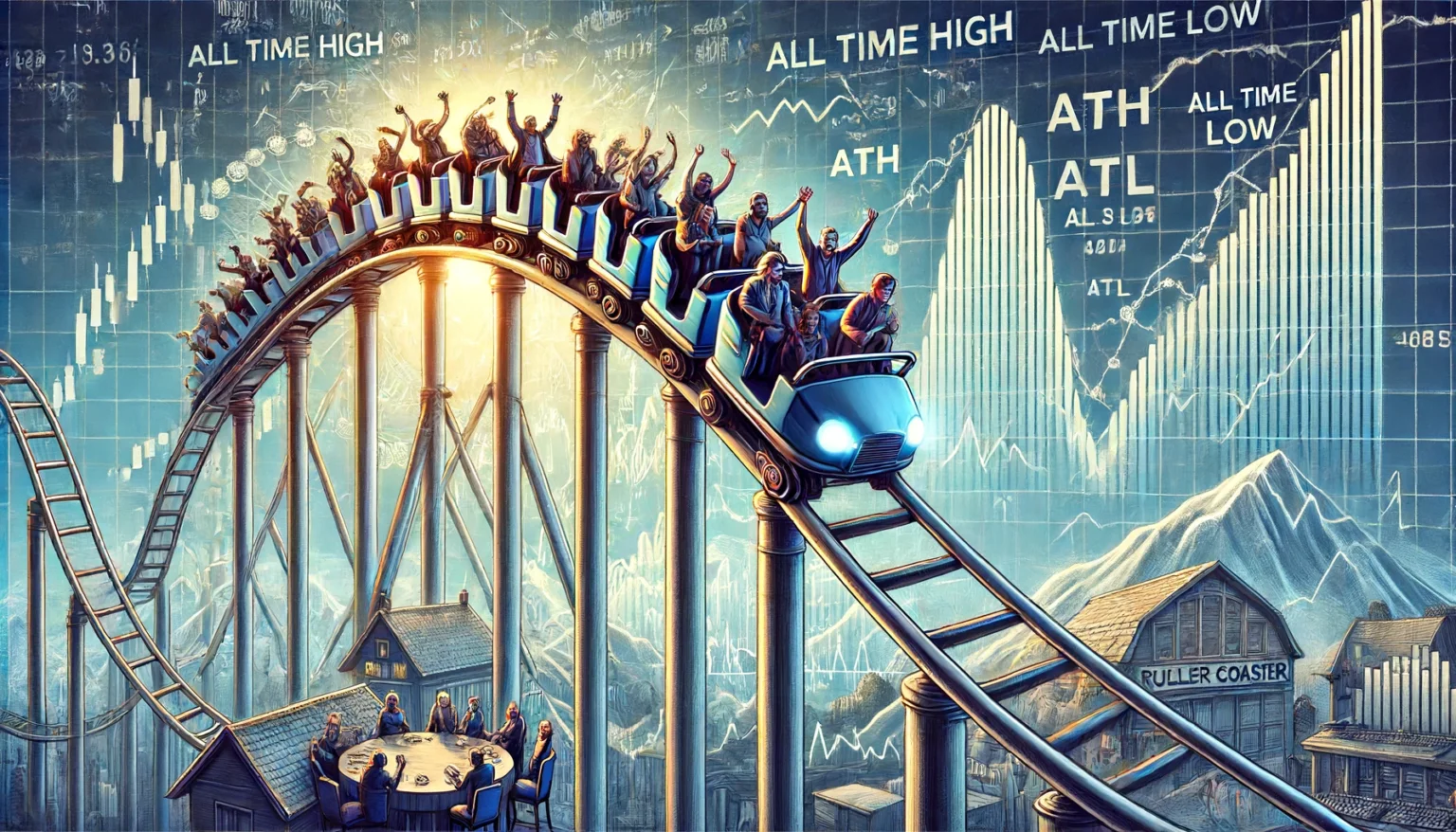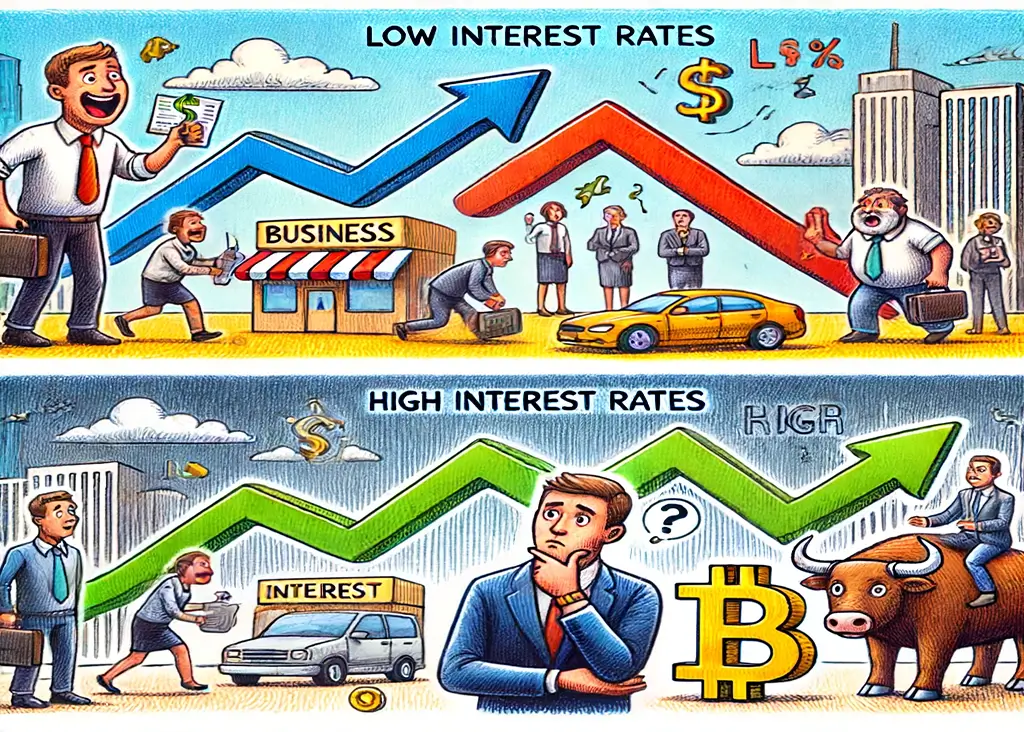کرپٹو مارکیٹ میں آپ نے آل ٹائم ہائی (ATH) اور آل ٹائم لو (ATL) جیسی اصطلاحات سنی ہی ہونگی۔ یہ کیا ہوتی ہیں اور کیسے ایک مارکیٹ بتدریج اپنے آل ٹائم ہائی (ATH) اور آل ٹائم لو (ATL)کی طر ف جاتی ہے۔
اس کو سمجھنے کیلئے پارکوں میں لگے کسی رولر کوسٹر کو دیکھئے!رولر کوسٹردھیرے دھیرے کبھی اونچائیوں کی طرف چڑھتا ہے تو کبھی ڈھلوانوں سے اترتا ہے ۔ ہر دو مقام پر چڑھتے اور اترتے ہوئے سنسنی کا احساس ہوتا ہے ۔ فائنانشل مارکیٹس ایسی ہی کسی رولرکوسٹرکی مانند چلتی ہیں اورمسلسل اپنی بلندیوں کی طرف چڑھتی اوراترائیوں میں گرتی جاتی ہیں ۔ مارکیٹ کا یہ سائیکل سمجھنا خود کو کسی بدترین نقصا ن سے بچانے اورملنے والے مواقع سے فائدہ اٹھانے میں نہایت مفید ثابت ہوسکتا ہے اور آپ کیلئے انویسٹمنٹ کے بروقت اورصحیح فیصلے لینےمیں مددگار ہوسکتا ہے۔
فائنانشل مارکیٹ سائیکلز کی بنیادی باتیں
تمام فائنانشل مارکیٹس جیسے اسٹاکس، بانڈز اور کرپٹو کرنسیز ، سائیکلز میں کام کرتی ہیں۔ ان سائیکلز میں ایک کو بُل مارکیٹ کہا جاتا ہےجہاں مارکیٹ اوپر سے اوپر جارہی ہوتی ہے اور دوسرا بئیر مارکیٹ ہے جہاں مارکیٹ اپنے زوال کی طرف گامزن ہوتی ہےا ور نیچے سے نیچے جارہی ہوتی ہے ۔ فائنانشل مارکیٹس کے یہ سائیکلز بیرونی عوامل جیسے اقتصادی حالات، عالمی واقعات، جنگیں اور شرح سود میں تبدیلیوں کی وجہ سے متاثر بھی ہوسکتے ہیں اور ان کی حرکت پر فرق پڑسکتا ہے۔
مثال کے طور پر، 2022 اور 2023 کے درمیان کی مدت کو میں امریکہ میں شرح سود 5.5% تک بڑھ چکی تھی اور اس اضافے نے تمام فائنانشل مارکیٹس پر کافی منفی اثر ڈالا تھا۔ اس کی وجہ واضح تھی کہ جب شرح سود زیادہ ہوگی تو لوگ اپنا پیسہ بینکوں میں رکھنے کو ترجیح دیں گے اور کیونکہ وہاں سےمنافع زیادہ ملنا شروع ہوجاتا ہے اور کوئی رسک بھی نہیں ہوتااورتمام رسکی مارکیٹس جیسے اسٹاکس اورکرپٹو کرنسیز سے لوگ اپنا پیسہ نکالنا شروع کردیتے ہیں۔پھر شرح سود میں اضافے کی وجہ سے مختلف کمپنیز جو ڈویلپمنٹ اورانویسٹمنٹ کے پلان کررہی ہوتی ہیں وہ متاثر ہوجاتا ہے کیونکہ قرضہ لینے پر زیادہ اخراجات یعنی سود کی ادائیگی کرنی پڑتی ہے اور یہ چیز ان کےبیلنس شیٹس اور اسٹاک کی قیمتوں پر منفی اثر ڈال سکتے ہیں۔
فائنانشل مارکیٹس پرشرح سود کا اثر
کسی کاروبار پر شرح سود کیسے اثر انداز ہوتی ہے اس کو ایک مثال سے سمجھتے ہیں ۔فرض کریں کہ آپ کاروبار کر رہے ہیں اوراپنے کاروبارکو بڑھانا چاہتے ہیں جس کیلئے پیسہ آپ قرض لینا چاہتے ہیں تو اگر شرح سود کم ہوگی تو آپ کم شرح سود کے ساتھ قرض لے سکتے ہیں جو آپ پر بھاری نہیں گزرے گا ۔ اس سے آپ کی کاروباری سرگرمی بھی بڑھے گی اور نتیجتاً آپ کی کمپنی کے اسٹاکس کی قیمت بڑھ جائے گی لیکن اگر شرح سود زیادہ ہوئی تو اس صورت میں یہ آپ کیلئے مشکل کھڑی کردیتی ہے اور آپ کیلئے قرضہ لینا ایک دشوار فیصلہ ثابت ہوجاتا ہے اور قرض نہ لینے کی صورت میں کاروبار کو بڑھا نے کا آپ کا خواب پورا نہیں ہوپاتا اور نتیجتاًایک طرف منافع میں کمی تو دوسری طرف اسٹاکس کی قیمتوں میں کمی کا باعث بن سکتی ہے۔
یہی وجہ ہے کہ سرمایہ کار شرح سود میں تبدیلیوں پر قریب سے نظر رکھتے ہیں۔ شرح سود میں اضافہ عام طور پر کاروبار کیلئے ناسازگار حالات کی طرف اشارہ کرتا ہے، جس کی وجہ سے اسٹاکس کی قیمتیں گرنےلگتی ہیں اور ایک بیئر مارکیٹ کا آغاز ہوسکتا ہے۔ اس کے برعکس، جب کوئی حکومت شرح سود کم کرتی ہے تو یہ اقتصادی سرگرمی کو بڑھاوادیتی ہے ، اسٹاکس کی قیمتیں اوپر جانے لگتی ہیں اور یوں بل مارکیٹ کا آغاز ہوسکتا ہے۔
بٹ کوائن اور کرپٹو کرنسیز کے سائیکلزکی نوعیت
بٹ کوائن بھی دیگر فائنانشل مارکیٹس کی طر ح ان سائیکلز پیٹرن کو فالو کرتا ہے، اگرچہ روایتی فائنانشل مارکیٹس کے مقابلے میں بٹ کوائن سائیکلز کی تاریخ اتنی لمبی نہیں ہے۔ بٹ کوائن کا سائیکل عموماً چار سال پر محیط ہوتا ہے اور اس میں ایک سال تیز رفتار گروتھ (بل رن)چلتی ہے ایک سال کمی (بیئر مارکیٹ)چلتی ہے اور دو سال ریکوری اور استحکام کے ہوتے ہیں۔
بٹ کوائن کے ہر سائیکل میں سب سے اہم ترین چیز ہر چار سا ل کے بعد ہونے والی “ہاؤنگ” ہے۔ ہرہاؤنگ کے دوران، بٹ کوائن کےنئے بلاکس کی مائننگ کا ریوارڈ آدھا ہو جاتا ہے، جس سے نئے بٹ کوائن کی سپلائی میں کمی واقع ہوجاتی ہے۔ سپلائی کی یہ کمی عموماً بل رن کا سبب بنتی ہے لیکن قیمتوں میں بڑا اور تیزی سے اضافہ عام طور پر ہاؤنگ کے چند مہینے بعد شروع ہوتا ہے۔
لیکن جیسے ذکر ہوا کہ کئی چیزیں مارکیٹ سائیکلز کو متاثر کرتی ہیں ۔ بٹ کوائن کے مارکیٹ سائیکل کے ساتھ بھی ایسا ہوتا ہے جیسے 2022 میں جب روس نے یوکرین پر حملہ کیا، تو بٹ کوائن اور اس جیسے دیگر رسکی ایسٹس کی قیمتوں میں شدید کمی ہوئی جیسےکوئی بئیر مارکیٹ چل رہی ہو ۔
بٹ کوائن اور کرپٹو کرنسیز کے سائیکلز نوعیت کی حقیقی مثالیں
2013 کا سائیکل اور پہلی آل ٹائم ہائی (ATH)
2013 میں، بٹ کوائن اپنے پہلے بڑے بل رن سے گزرا۔ سال کے آغاز میں، بٹ کوائن کی قیمت تقریباً $13 تھی۔ اپریل تک، یہ بڑھ کر $260 سے تجاوز کر گئی۔ یہ بٹ کوائن کی قیمت میں ایک بہت نمایاں اضافہ تھا۔ اس اضافے میں میڈیا کی بڑھتی ہوئی کوریج اور لوگوں کی کرپٹو کرنسیز میں بڑھتی ہوئی دلچسپی نے بہت اہم کردار ادا کیا تھا۔ تاہم، اس تیزی سے اضافے کے بعد، بٹ کوائن کی قیمت میں تیزی سے کمی بھی آئی اور سال کے وسط تک قیمت تقریباً $50 تک گر گئی۔ اس کے بعد مارکیٹ بل رن کے دوسرے مرحلے میں داخل ہوئی اور 2013 کے آخر تک، بٹ کوائن نے ایک نیا آل ٹائم ہائی تقریباً $1,150 تک پہنچا دیا، جس کے بعد ایک بیئر مارکیٹ شروع ہو گئی۔
2017 کا سائیکل
2017 کا بٹ کوائن سائیکل کرپٹو کی دنیا میں سب سے زیادہ معروف سائیکلز میں سے ایک ہے۔ بٹ کوائن نے سال کا آغاز تقریباً $1,000 سے کیا اور ایک دھماکہ خیز بل رن کے ساتھ دسمبر میں تقریباً $20,000 کے آل ٹائم ہائی تک پہنچ گیا۔ اس اضافے میں بٹ کوائن کی اڈاپشن ، بٹ کوائن فیوچرز مارکیٹس کے آغاز اور ریٹیل انویسٹرز کی طرف سے بہت زیادہ دلچسپی نے اہم کردار ادا کیا تھا۔ تاہم، یہ عروج مختصر مدت کے لئے تھا اور بٹ کوائن 2018 میں ایک طویل بیئر مارکیٹ میں داخل ہو گیا، جس میں بٹ کوائن دسمبر 2018 تک تقریباً $3,200 تک گر گیا۔ یہاں سے ریکوری اور استحکام کا مرحلہ شروع ہوا اور اگلے دو سالوں میں بٹ کوائن نے آہستہ آہستہ اپنی قیمت دوبارہ حاصل کی۔
2020 2021 کا سائیکل
یہ بٹ کوائن کا سب سے حالیہ سائیکل ہے جس کی شروعات 2020 میں ہوئی۔ COVID 19 کی وبا کے آغاز میں بٹ کوائن کی قیمت میں تیزی سے کمی ہوئی، مارچ 2020 میں یہ تقریباً $4,000 تک گر گئی۔ تاہم، جوں جوں دنیا بھر کی حکومتوں نے بہترین فائنانشل اقدامات نافذ کیے اور شرح سود میں کمی لائی گئی جس کی وجہ سےانویسٹرزنے دوبارہ اسٹاکس اور کرپٹو جیسے رسکی اثاثوں کی طرف رخ کیا یوں ایک اور بل رن کا آغاز ہوا۔ دسمبر 2020 تک، بٹ کوائن نے اپنے پچھلے آل ٹائم ہائی کو کراس کر لیا تھا اور اپریل 2021 تک، اس نے$64,000 ایک نئے ہائی کو ٹچ کر لیا ۔
اس بل رن کے پیچھے کئی اہم عوامل تھے جیسے بڑے اداروں کی طرف سے بٹ کوائن کی اڈاپشن( Tesla اور MicroStrategy جیسی بڑی کمپنیز نے بٹ کوائن میں بھاری انویسٹمنٹ کی۔)بٹ کوائن کی سٹور آف ویلیو کے طور بڑھتی مقبولیت اور وسیع پیمانے پر میڈیا کوریج۔ تاہم، 2021 کے وسط تک، بٹ کوائن کو ایک تیز کریکشن کا سامنا کرنا پڑا اور اس کی قیمت تقریباً $30,000 تک گر گئی۔ اس کریکشن کے پیچھے بٹ کوائن کی بہت بھاری مقدار میں توانائی کے استعمال کی وجہ سے پید ا ہونے والے ماحولیاتی خدشات اور چین میں بٹ کوائن کی ریگولیٹری کو لے کر تشویش نے اہم کردار ادا کیا تھا کیونکہ چائنیز حکومت نےکرپٹو کرنسی مائننگ اور ٹریڈنگ پر کریک ڈاؤن شروع کردیا تھا۔اس کریکشن کے بعد اس بل رن کا دوسرا مرحلہ شروع ہوا اور بٹ کوائن کی قیمت $69,000 تک پہنچ گئی، یہاں سے بٹ کوائن نے ریورس لیا اور دوبارہ سے بیئر مارکیٹ کا آغاز ہوا۔
خارجی واقعات کی اثراندازی
جیسا کہ پہلے ذکر کیا گیا ہے، بٹ کوائن کی قیمت صرف اندرونی عوامل جیسے ہاؤنگ سے ہی متاثر نہیں ہوتی بلکہ خارجی واقعات بھی اس پر پازیٹیو یا نیگیٹیو اثر ڈالتے ہیں ۔ 2022 میں روسی یوکرین پر حملہ اس کی ایک اہم مثال ہے۔ جب یہ تنازعہ شروع ہوا تو عالمی فائنانشل مارکیٹس بشمول کرپٹو کرنسیز کے میں بڑی اتھل پتھل دیکھی گئی۔ایسے حالات کے دوران انویسٹرز کوشش کرتے ہیں کہ رسکی ایسٹس سے دور رہیں یوں بٹ کوائن بھی اس کی زد میں آیا اور اس کی قیمت تیزی سے گرنے لگی۔ اس چیز نے پہلے سے موجود بیئر مارکیٹ کی صورتحال کو مزید بگاڑ دیا۔
مارکیٹ سائیکلز کو نہ سمجھنے کی غلطیاں
بہت سے لوگ جو مارکیٹ سائیکلز کو نہیں سمجھتے، وہ بُل رن کے دوران مارکیٹ میں داخل ہونے کی غلطی کرتے ہیں، جب ساری قیمتیں اپنے عروج پر ہوتی ہیں۔ اب یہ لوگ قیمتوں کے مسلسل اوپر جانے سے لالچ میں آجاتے ہیں اور بھاری انویسٹمنٹ کرتے ہیں، لیکن ظاہر ہے مارکیٹ کا اصول ہےکہ وہ ایک ہی حالت میں نہیں رہتی جلد ہی مارکیٹ بیئر فیز میں داخل ہو جاتی ہے۔اب گرتی ہوئی قیمتوں سے یہ لوگ پریشان اور خوفزدہ ہوجاتے ہیں کہ مارکیٹ اب نیچے سے نیچے ہی جائے گی اور اپنی انویسٹمنٹ کو نقصان پر فروخت کر دیتے ہیں۔
یہ صورتحال صرف کرپٹو کرنسیز میں ہی نہیں بلکہ تمام فائنانشل مارکیٹس میں عام ہے۔ اس کے برعکس، ماہر ٹریڈرز سائیکلز کو سمجھتے ہیں اور اکثر وہ ان حالات میں عام لوگوں کے برعکس اسٹریٹجی اپناتے ہیں۔ ان کا طریقہ کار یہ ہوتا ہے کہ وہ بیئر مارکیٹس کے دوران جب قیمتیں گر رہی ہوتی ہیں ، لوگ مارکیٹ سے نکل رہے ہوتے ہیں ، اس وقت وہ مارکیٹ میں انٹری لے رہے ہوتے ہیں اور خریداری کرتے ہیں اور بُل مارکیٹس کے دوران جب قیمتیں اوپر سے اوپر جارہی ہوتی ہیں اور لوگ لالچ میں آکر مارکیٹ میں انٹری لے رہے ہوتے ہیں ، اس وقت وہ اپنا منافع سمیٹ کر مارکیٹ سے نکلنے کی تیار ی کر رہے ہوتے ہیں ۔
مارکیٹ کے اوپر اور نیچے جانے کی پیش گوئی
اگرچہ یہ یقینی طور پر پیش گوئی کرنا ناممکن ہے کہ مارکیٹ کب اپنے ٹاپ یا باٹم تک پہنچے گی ہاں البتہ اس کیلئے صورتحال کا جائزہ لےکر کچھ نہ کچھ اندازے لگائے جاسکتے ہیں ۔ بٹ کوائن کو ہم بطور مثال لے لیتے ہیں ۔ 2017 میں، بٹ کوائن کا آل ٹائم ہائی تقریباً $20,000 تھا ، جس میں $28,000 پر اہم سپورٹ تھی۔ 2021 تک، بٹ کوائن $69,000 کے نئے آل ٹائم ہائی تک پہنچا ، جہاں سے ریورس ہو کر واپس بیئر مارکیٹ میں داخل ہوا۔اس کے پے درپے مختلف نیگٹیو واقعات کے باوجود، بٹ کوائن کی قیمت اپنے مرکزی سپورٹ لیول کے آس پاس ہی رہی ، یہاں تک کہ ایک موقع پر $15,500 تک گر گئی مگر پھر ریکور ہو کر $65,000 کے قریب پہنچ گئی۔
اب جن لوگوں نے یہاں قیمت کے باٹم کا درستگی کے ساتھ لگایا اور اس کے مطابق $15,500 یا اس کے آس پاس بٹ کوائن خریدا، قیمت کی ریکوری کے بعد ان کا منافع تین سے چار گنا تک ہوچکا تھا۔
اسٹاک ٹو فلو ماڈل سے قیمتوں کی پیش گوئی
بٹ کوائن کی مستقبل کی قیمتوں کا اندازہ لگانے کا ایک طریقہ اسٹاک ٹو فلو ماڈل ہے، جس میں اس ایسٹ کی کمی کو موجودہ اسٹاک (ٹوٹل سپلائی) اور فلو (سالانہ پیداوار) کا موازنہ کرکے ماپتا ہے۔ تاریخی طور پر اگر دیکھا جائے تو بٹ کوائن کی قیمت اکثر اس ماڈل کے تجویز کردہ لیولز کے آس پاس ہی رہی ہے ۔ تاہم، یہ جاننا ضروری ہے کہ یہ پیش گوئیاں بس ایک فائنانشل اندازے ہوتے ہیں ا ور ان کے ساتھ ساتھ دیگر اسٹریٹجیز اور مارکیٹ انڈیکیٹرز کو مدنظر رکھنا چاہیے ۔
ہاؤنگ ایونٹ اور اس کا اثر
ہاؤنگ ایونٹ بٹ کوائن کے مارکیٹ سائیکلز میں ایک اہم کردار ادا کرتا ہے۔ جب نئے بٹ کوائنز کی تخلیق کی شرح کم ہوتی ہے، تو ہاؤنگ سپلائی کو کم کرتی ہے اور دوسری طرف ڈیمانڈ اسی طرح رہے یا بڑھتی رہے تو سپلائی کی یہ کمی قیمت میں اضافے کا باعث بنتی ہے۔ سپلائی میں کمی کا میکانزم بلکل ویسا ہی ہے جیسے مرکزی بینک پیسے کی سپلائی کو کنٹرول کرکے افراط زر اور اکنامک گروتھ پراثرانداز ہوتے ہیں۔
مثال کے طور پر، مئی 2020 کی ہاؤنگ میں مائنرز کے فی بلاک ریوارڈ ز 12.5 بٹ کوائنز سے کم ہو کر 6.25 بٹ کوائنز ہوگئے۔ اس ایونٹ کے بعد آنے والے مہینوں میں بٹ کوائن کی قیمت مسلسل بڑھنا شروع ہوئی اور آخرکار 2020 کے آخراور 2021 کے شروع میں بٹ کوائن بل رن میں داخل ہوگیا ۔ پرانے پیٹرنز کو دیکھا جائے تو معلوم ہوتا ہے کہ ہاؤنگ فوری طور پر کچھ خاص اثر نہیں ڈالتی لیکن سپلائی میں کمی بالآخر قیمتوں میں اضافے کا باعث بنتی ہے اور عام طور پر ہاؤنگ کے 12 سے 18 مہینوں کے اندر ایک نیا بل سائیکل شروع ہوتا ہے۔
بٹ کوائن کے علاوہ :آلٹ کوائنز اور ان کے سائیکل
چونکہ بٹ کوائن ہی کرپٹو مارکیٹ کا سرخیل ہے اور یہی مارکیٹ کو لے کر چلتا ہے تو دیگر کرپٹو کرنسیز ، جنہیں عام طور پر آلٹ کوائنز کہا جاتا ہے وہ بھی بٹ کوائن کے سائیکل پیٹرن کو فالو کرتی ہیں۔ مثال کے طور پر، ایتھیریم کا اپنا ایک بوم اور بسٹ کے سائیکل ہوتا ہے جوعموما بٹ کوائن کو فالو کرتا ہےمگر کبھی ایتھیریم کے اپنے یونیک فیکٹرز سے اس پر اثر پڑتا ہے جیسے ٹیکنیکل اپ گریڈز یا پھر نیٹ ورک ڈویلپمنٹس۔
مثال کے طور پر، ایتھیریم کی ایتھیریم 2.0 میں ٹرانزیشن ایک اہم اپ گریڈ تھی جس کا مقصد اسکیل ایبلٹی اور سیکورٹی کو بہتر بنانا تھا۔ اس اپ گریڈ نے ایتھیریم کی قیمت پر بہت اثر ڈالا۔ اسی طرح، 2020 اور 2021 میں ایتھیریم نیٹ ورک پر بنائے گئےڈی سنٹرلائزڈ فائنانس (DeFi) کے پروجیکٹس کی بھرمار نے اس کے اہم بل رن میں کردار ادا کیا۔
وسیع تر اقتصادی اثرات
فائنانشل مارکیٹس کی سائیکل کی نوعیت صرف انفرادی انویسٹرز کو ہی متاثر نہیں کرتی بلکہ اس کے وسیع تر اقتصادی اثرات بھی ہوتے ہیں۔ چنانچہ جب مارکیٹ بل فیز میں ہوتی ہے تو اس وقت انویسٹمنٹ بھی زیادہ ہوتی ہے جس سے اقتصادی ترقی اور یوزرز کے اعتماد میں اضافہ ہو سکتا ہے ، نئی جابز تخلیق ہوتی ہیں اور روزگار کے مواقع کھلتے ہیں ۔ اس کے برعکس، جب مارکیٹ بیئر فیز میں ہوتی ہے تو انویسٹمنٹ کم ہوجاتی ہے جس سے اقتصادی سکڑاؤ آنے لگتا ہے اور یوزرز اعتماد کھونے لگتے ہیں اور یہ سب روزگار میں کمی کا باعث بننے لگتے ہیں ۔
حکومتیں اور مرکزی بینک اکثر مانیٹری اور مالیاتی پالیسیوں کے ذریعے ان سائیکلز کو منظم کرنے کی کوشش کرتے ہیں۔ مثال کے طور پر، کساد بازاری(ریسیشن) کے دوران، مرکزی بینک شرح سود کم کر تے ہیں تاکہ قرض لینے اور انویسٹمنٹ کی حوصلہ افزائی ہو سکے، جس سے اقتصادی سرگرمیوں میں بڑھوتری پیدا ہو۔ اس کے برعکس، تیز رفتار اقتصادی ترقی کے دوران، وہ معیشت کو زیادہ اوور ہیٹ ہونے سے بچانے اور انفلیشن کو کنٹرول میں رکھنے کے لیے شرح سود بڑھا تے ہیں۔
مارکیٹ سائیکلز کا نفسیاتی پہلو
انویسٹرز کی نفسیات بھی مارکیٹ سائیکلز میں ایک اہم کردار ادا کرتی ہے۔ بل مارکیٹس کے دوران قیمتوں کے اوپر جانے سے خوشی کا ماحول ہوتا ہے اورلوگ قیمتوں کو اوپر جاتا دیکھ کر لالچ میں آتے جاتے ہیں اور توقع کرتے ہیں کہ قیمتیں بڑھتی رہیں گی یوں اور زیادہ انویسٹمنٹ کرتے جاتے ہیں ۔ یہ چیز ایسٹس میں ایک ببل بناتی ہے، جہاں مارکیٹ کی قیمتیں ایسٹس کی حقیقی قیمت سے زیادہ ہو جاتی ہیں۔ جب یہ ببل پھٹتا ہے، تو قیمت تیزی سے گرنے لگتی ہےاور بیئر مارکیٹ پیدا ہوتی ہے، جس میں خوف اور گھبراہٹ کی فضا بنتی ہے اور لوگ اپنے ایسٹس فروخت کرنے لگتے ہیں ۔
مارکیٹ سائیکلز کے نفسیاتی پہلو کو سمجھنے سے انویسٹرز زیادہ معقول اور بہتر فیصلے کر سکتے ہیں۔ جو انویسٹر یہ جان گیا کہ مارکیٹ کا اوپر نیچے جانا یہ مارکیٹ سائیکلز کا حصہ ہے تو وہ نہ تو بیئر مارکیٹس کے دوران حواس باختہ ہو کر اپنے ایسٹس کو نقصان میں فروخت کرے گا نہ ہی بل مارکیٹس کے دوران لالچ اور جلد بازی کا شکار ہو کر مہنگا خریدے گا۔ ایسے ہوشیار انویسٹرز شارٹ ٹرم میں مارکیٹ کے اتار چڑھاؤ کو نظر انداز کر کے اپنے انویسٹمنٹ کی بنیادی قیمت پر توجہ مرکوز کرتے ہیں ۔
مارکیٹ سائیکلز میں رہنمائی کے لیے عملی اسٹریٹجیز
تنوع (Diversification)
اپنے سرمایہ کو مختلف ایسٹس کلاسز (اسٹاکس، بانڈز، رئیل اسٹیٹ، وغیرہ) میں تقسیم کریں تاکہ رسک کم ہو سکے۔ اس کا فائدہ یہ ہوگا کہ اگر کوئی ایک مارکیٹ نیچے ہوگی تو دوسری اوپر ہو سکتی ہے، جس سے آپ کا مجموعی پورٹ فولیو متوازن رہے گا۔
ڈالر کاسٹ ایوریجنگ: (Dollar Cost Averaging)
مارکیٹ چاہے بئیر موڈ میں ہو یا بل لیکن ہمیشہ ایک مقررہ اور مناسب مقدار میں انویسٹ کریں۔ یہ اسٹریٹجی آپ کو مارکیٹ کے اچانک منفی اثرات اور اتار چڑھاؤ میں کم سے کم متاثر کرے گی۔
باخبر رہیں: (Stay Informed)
اقتصادی خبریں اورمارکیٹ کے ٹرینڈز سے باخبر رہیں۔ مارکیٹ سائیکلز کو چلانے والے فیکٹرز کو سمجھنے سے آپ کو مناسب اوربہتر فیصلے کرنے میں مدد مل سکتی ہے۔
ایک منصوبہ بنائیں : (Have a Plan)
انویسٹمنٹ کےواضح اہداف مقرر کریں اور اپنے پلان سے ادھر ادھر نہ ہوں ۔ شارٹ ٹرم میں مارکیٹ مومنٹ سے متاثر ہوکر کسی قسم کے جذباتی فیصلے نہ لیں ۔
پیشہ ورانہ مشورہ حاصل کریں (Seek Professional Advice):
کسی فائنانشل ایڈوائزر کے ساتھ کام کرنے پر غور کریں جو آپ کے پورٹ فولیواور حالات دیکھ کر آپ کے لئے مناسب فائنانشل مشورے اور راہنمائی کرسکے اور آپ کو پیچیدہ مارکیٹ سائیکلز میں رہنمائی کر سکے۔
تاریخی سائیکلز سے سیکھنا
ماضی کے مارکیٹ سائیکلز کا مطالعہ مستقبل کے مارکیٹ رویے کے بارے میں قیمتی معلومات فراہم کرسکتا ہے۔ مثال کے طور پر، 1930 کی دہائی کا گریٹ ڈپریشن ، 1990 کی دہائی کے آخر کا ڈاٹ کام ببل اور 2008 کا مالی بحران سبھی میں ایسا ہوا ہے کہ پہلے تیز رفتاری سے گروتھ ہوئی اور ایسٹس کی قیمتیں بلبلے بنا گئی جو پھٹ پڑے تو پے در پے کریش آنے لگ پڑے۔
اگر انویسٹرز ان تاریخی ایونٹس کا مطالعہ اور ان کا تجزیہ کریں تووہ ان مارکیٹس کے اوپر جانے اور گرنے کے اشاروں پر عبور حاصل کرسکتے ہیں ۔ جیسے اگر مارکیٹ میں ایسٹس کی قیمتیں مسلسل اوپر کی جانب جارہی ہیں اور لالچ میں آکر وسیع پیمانے پر لوگ مسلسل انویسٹ کرتے جارہے ہیں تو اس بات کی علامت ہوسکتی ہےکہ اب کسی بھی وقت کریش آسکتا ہے ۔ اس کے برعکس اگر مارکیٹ میں مایوسی اور خوف پھیلا ہوا ہو اور ایسٹس کی قیمتیں گر چکی ہوں تو مارکیٹ کے باٹم تک پہنچ جانے کا اشارہ ہے اور خریداری کا موقع ہوسکتا ہے۔
نتیجہ: مارکیٹ سائیکلز سے دوستی
فائنانشل مارکیٹس بہت زیادہ دلچسپ ہوتی ہیں اور کسی رولر کوسٹر کی طرح اتار چڑھاؤ سے بھری ہوتی ہیں۔ ان سائیکلز کو سمجھنا انویسٹرز کو بہتر اور مناسب فیصلے کرنے، بار بار کی جانے والی عمومی غلطیوں سے بچنے اور مارکیٹ میں ملنے والے مواقع سے فائدہ اٹھانے میں مدد کرسکتا ہے۔ مارکیٹ مومنٹ پر اثر ڈالنے والے فیکٹرز جیسے شرح سود ، عالمی واقعات اور انویسٹرز کی نفسیات اور اسٹریٹجیز جیسے کہ تنوع diversification اور ڈالر کاسٹ ایوریجنگ، کو سمجھنے سے انویسٹرز زیادہ اعتماد اور کامیابی کے ساتھ اس فائنانشل رولر کوسٹر کو نیویگیٹ کر سکتے ہیں۔
کسی رولر کوسٹر کے موڑ اور گھماؤ کو جان لینا آپ کو اس کیلئے اس کی سواری آسان اور دلچسپ بناتا ہے ویسے ہی مارکیٹ سائیکلز کو سمجھنا آپ کے فائنانشل سفر کو کم ڈراؤنا اور زیادہ فائدہ مند بنا سکتا ہے۔ سائیکلز کو اپنائیں، باخبر رہیں اور بہتر فیصلے کریں تاکہ مارکیٹ کی اتار چڑھاؤ کو ترقی اور مالی کامیابی کے مواقع میں بدل سکیں۔




